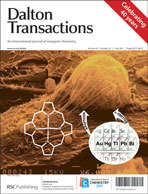AsS2Cl—an Arsenic(v) Compound? Formation, Stability and Structure of gaseous AsSCl and AsS2Cl—a combined experimental and theoretical study†
Abstract
By reaction of solid As4S4 with gaseous Cl2 at a temperature of 410 K gaseous AsSCl and AsS2Cl are formed. Unexpectedly in AsS2Cl the arsenic is not of formal ![[double bond, length as m-dash]](https://www.rsc.org/images/entities/char_e001.gif) S) = 4.47 mdyn·Å−1 gives rise to an As
S) = 4.47 mdyn·Å−1 gives rise to an As![[double bond, length as m-dash]](https://www.rsc.org/images/entities/char_e001.gif) S double bond.
S double bond.


 Please wait while we load your content...
Please wait while we load your content...